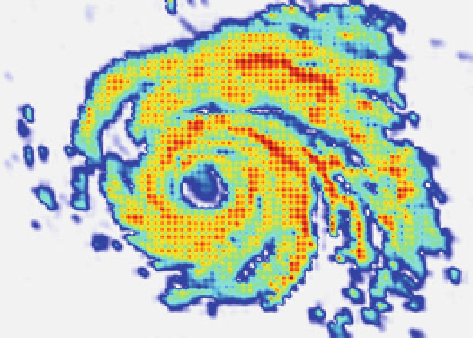Geoscience Reference
In-Depth Information
dBZ
50
45
40
35
30
25
20
15
10
5
0
Dim: [400 560] Range: [0, 59]
Fig. 9 VarD result for downscaling precipitation reflectivity from scale 8 9 8to1 9 1 km with a ''wrong''
observation operator. In this experiment, the imposed observation operator was a Gaussian filter of size
8 9 8 with standard deviation 2 while in downscaling, we assumed a uniform average filter of the same size.
It is clear from the result that the quality of downscaling is blocky and is severely deteriorated because of the
misspecification of the observation operator in the downscaling scheme. The selected quantitative measures
are as follows: MSE = 0.244; MAE = 0.220; PSNR: 22.0; and KLD = 0.075 (see Table
1
)
performance of the proposed downscaling scheme on a tropical storm and concluded that it
was able to capture adequately both the extremes of rainfall intensities and gradients.
A practical challenge faced in applying the proposed methodology is that the obser-
vation operator (which relates the true unknown HR field to the LR observations) might not
be known. In fact, it might be even changing locally due to sensor properties as affected,
for example, by range or precipitation intensity and composition. If coincidental high- and
low-resolution fields are available in a data base, the data-driven dictionary-based meth-
odology introduced by Ebtehaj et al. (
2012
) offers promise and, although more compu-
tationally intensive, it might offer advantages in capturing more faithfully local details and
extremes. However, a lot more work is needed to understand the sensitivity of the dic-
tionary-based methodology to the selection of a data base from environments different than
the storm of interest, as well as when the observation filter relates nonlinearly to the
underlying field as is the case in problems of retrieval, i.e., estimation of precipitation
intensity from radiances recorded by the TRMM microwave imager.
The presence of statistical self-similarity (scaling) in spatial rainfall, manifesting in log-
log linearity in the Fourier or wavelet power spectra and also in higher-order statistical
moments, has been well documented by now (see discussion in the introduction). This
structure, often explained in the context of mono or multifractal formalisms, has guided the
development of several stochastic downscaling methodologies (e.g., Rebora et al.
2006a
,
b
; Perica and Foufoula-Georgiou
1996
, among many others). The downscaled precipitation
fields produced by these models are, by construction, respecting the rainfall scaling laws;
however, they are not unique as multiple realizations of plausible high-resolution rainfall
fields with the same input parameters can be produced without following a specific opti-
mality criterion. On the other hand, the proposed downscaling methodologies produce
unique high-resolution rainfall fields based on the aforementioned optimality criteria that
also allow us to partially preserve the underlying non-Gaussian structure of the rainfall
fields. An important question that arises then is whether statistical scaling in rainfall fields,


























